The SP&S 700
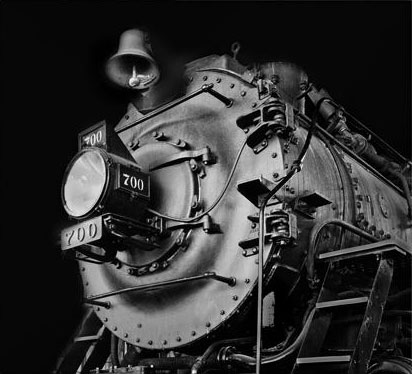
Photo by David Roy
The SP&S 700 is significant in almost every way. Its history is as important as any other locomotive in the Pacific Northwest, having provided the power for the premier passenger trains connecting one of the largest cities on the west coast with the Midwest and East. The locomotive is noteworthy from an engineering perspective as well, as it represents the state of the art of practical design, manufacture, and operation when steam was king on the nation's rails. It sports then-new features like Timkin roller bearings and boasts the highest axle-loading of any Northern-type locomotive ever produced in North America. Finally, the 700 is remarkable simply for the rare fact that it still operates more than 75 years after it was built, making it the largest steam locomotive currently in operation. And then there's the locomotive's obvious sensory significance: it's big, strong, hot, loud, smelly, and fast! This page explores the SP&S 700's place in history, facets of its engineering and design, the locomotive's restoration and maintenance by the PRPA, and its thunderous impact on the senses.
SP&S Service History
From 1912 onward, the Spokane, Portland & Seattle Railway provided the best freight and passenger route from Portland and the Columbia River Valley toward the east. Despite the fact that the railroad formed this important link, traffic on the new line was slow to develop, partially due to the intra-family competition between its builders, the Great Northern and Northern Pacific. Having no real need of the newest and most powerful locomotives, at first nearly all of the SP&S's engines were hand-me-downs from its parents. However, by the mid-1930s the railroad was woefully underpowered. Its largest passenger locomotives were Pacifics (4-6-2s), and its largest freight engines were Mikados (2-8-2s), with the newest of these having been built in 1920. The SP&S had a hard time competing against the newer, larger power owned by the Union Pacific and operated on the competing ex-OR&N line just across the Columbia River. Finally, in 1937, NP and GN allowed the SP&S to purchase its first new locomotives: three Northerns (4-8-4s) classed E-1 and six Challengers (4-6-6-4s) classed Z-6. The new SP&S engines were added onto Northern Pacific orders and were identical in design to NP's class A-3 Northerns and class Z-6 Challengers except that they were built to burn oil instead of coal.
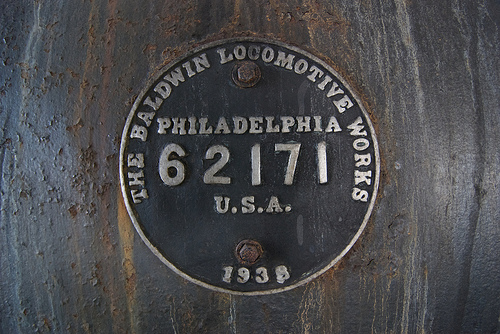
Builder's Plate of the SP&S 700
Photo by Chris Chen
Baldwin Locomotive Works delivered the Northerns to the Spokane, Portland & Seattle Railway in 1938 as numbers 700, 701, and 702. The 700 was the first to arrive and was shown off to communities along the company's mainline before entering regular service. The new 4-8-4s were specifically purchased to power the SP&S's premier passenger service. This train—No. 1 westbound from Spokane and No. 2 on the return from Portland—included the Portland segments of GN's famous Empire Builder and NP's North Coast Limited. Both originated in Chicago (running over the CB&Q from Chicago to St. Paul) and were broken into two sections in eastern Washington, with one segment bound for Portland via the SP&S and the other bound to Seattle over the Cascades. Two of the locomotives, typically 700 and 702, were employed almost continuously in this service, with the 701 operating freight on the mainline except when filling in for one of her sisters when they required servicing. The engines' good looks and graceful operation soon earned them the nickname "The Ladies." As the 700 was the first on the property, she became known colloquially as "The First Lady of the Northwest" or simply "The Lady."
During its regular service life, The Lady played an important role in developing and maintaining the prominence enjoyed by the City of Portland, and it is an integral part of the city's history and culture as well as that of the Columbia River Valley and eastern Washington. Recognizing this, the SP&S donated the 700 to the City of Portland in the final days of steam, sparing it from the scrapper's torch. The locomotive remains the property of the City, but it is officially under the care of the PRPA. Visit our page on Portland's railroad history or peruse the websites of the Pacific Northwest Chapter of the National Railway Historical Society and the Spokane, Portland & Seattle Railway Historical Society to deepen your understanding of the important role that railroads played in the development of the Northwest.
Details of the 700's service history are captured below:
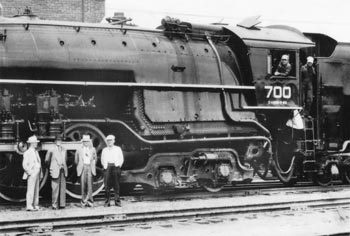
Dignitaries of the Spokane, Portland & Seattle Railway pose with #700 on the occasion of its delivery in 1938
From the collection of Vern Vasey
- 1938 - In June, the SP&S took delivery of #700 from the Baldwin Locomotive Works. It was the first of three locomotives designated as class E-1. The group were oil-burning versions of eight Northern Pacific coal-burning locomotives designated as class A-3, and were part of the same order. The NP series 2660-2667 were built first, followed by SP&S 700-702.
- 1938 - On its trial run west from Spokane, the SP&S 700 stops in front of a rock slide that has blocked the tracks near Snake River Junction. The slide is cleared, but a second slide comes down as the train pulls ahead and strikes the engine, tearing away shielding on the trailing truck.
- 1938 - SP&S 700 and 702 are assigned service as the primary power for the first-class passenger trains (Nos. 1 & 2) between Vancouver, WA and Spokane, WA. The trains carry the Portland sections of the Great Northern's Empire Builder, interchanging cars in Spokane, and Northern Pacific's North Coast Limited, interchanging cars in Pasco. The more powerful locomotives allow the company to amend the schedules to include four additional intermediate stops over the previous 10 with the same 9:50(WB)/9:30(EB) running times between Portland, Pasco, and Spokane. The 4-6-2 Pacifics that had previously led these trains are given charge of the Columbia River Express, trains 3 & 4, with mail and secondary passenger service (including cars to/from the Oregon Trunk) between Portland and Pasco. SP&S 701 primarily hauls freight, but fills in for the 700 and 702 when necessary.
- 1941-1942 - Management temporarily assigns the E-1s to freight service in an attempt to help keep up with increasing traffic during World War II. Trains 1 & 2, led once again by Pacifics, have grown to 14 cars and are often late, so the Northerns are returned to their former service.
- 1943 - SP&S trains 1 & 2 begin in April to be handled in two sections to support the heavy wartime troop movements. Pacifics lead the 1st sections, consisting of NP cars interchanging at Pasco while the Northerns pull the 2nd sections with GN cars interchanging at Spokane.
- 1944 - Construction of the Hoyt Street Roundhouse and its 110 ft. turntable allows the 700 and its two sister engines to deliver trains 1 & 2 directly to Portland Union Station. Previously, the lack of facilities large enough to service and turn the big 4-8-4 Northerns near the station meant that trains 1 & 2 were powered by smaller 4-6-2 Pacific-type or 4-4-2 Atlantic-type locomotives between Portland and Vancouver, WA, with an engine change at the latter city.
- 1945 - SP&S 700 pulls a train of delegates returning from the United Nations Conference on International Organization in San Francisco. This historic meeting resulted in the creation, adoption, and signing (on June 26) of the U.N. Charter, which will be ratified by the five member nations of the Security Council on October 24.
- 1945 - Trains 1 & 2 are returned to single section operation behind the E-1s on August 30, but patronage is still heavy enough to require 18-20 cars.
- 1947 - The Great Northern re-equips its premier passenger train, the Empire Builder, with new EMD F7A diesel locomotives and new lightweight streamlined cars. It also drops many intermediate stops to speed up the Builder's schedule, which means that it needs a new secondary train to pick up all the dropped stops and new time for its interchange with the SP&S in Spokane. As for the new secondary train, the company reinstates the Oriental Limited on the Empire Builder's former schedule. As for the new connection, the SP&S inaugurates a new train, the Streamliner. Operation of the Streamliner begins February 23 behind a Pacific-type steam locomotive until a pair of F3A units (#800) on order from EMD can be placed in service on July 14. The pre-existing SP&S passenger trains continue operating, but under new numbers. Old Nos. 1 & 2 become Nos. 3 & 4, still led by the class E-1 Northerns. Trains 3 & 4 continue to interchange cars in Pasco with NP's North Coast Limited, which also gets new equipment but retains its slower schedule for now. Trains 3 & 4 also haul the Portland section of GN's Oriental Limited between Portland and Spokane. Old Nos. 3 & 4, the Columbia River Express with mail and local passenger traffic behind Pacifics, become Nos. 5 & 6.
- 1947 - On March 25th, the 700, leading train No. 4 near Redd, WA, hits a rock slide at 45mph. The engine and three head end cars derail and slide down a steep slope towards the Snake River. It takes two weeks to get the 700 back up the bank, and it comes back in pieces--workers have had to cut both the drawbar to separate the tender from the locomotive and the boiler supports to separate the boiler from the frame and running gear. The engine crew escapes with only minor injuries.
- 1951 - Great Northern's Oriental Limited is re-equipped to become the Western Star. The train continues to exchange cars with SP&S trains 3 & 4 in Spokane.
- 1952 - On November 16, Northern Pacific's North Coast Limited is given new numbers (No. 25 westbound and No. 24 eastbound) and a faster schedule that allows it to compete with GN's Empire Builder and Milwaukee Road's Olympian Hiawatha. The timing is set to allow for interchange with the SP&S Streamliner at Pasco. A new train, the Mainstreeter, takes over the North Coast Limited's numbers (train No. 1 westbound and No. 2 eastbound) and schedule. SP&S Northern-powered trains 3 & 4 connect with the Mainstreeter in Pasco, but do not interchange any through cars. The 700 and its sisters are now starting a short stint as second-class passenger power, but it won't last long.
8mm footage of the SP&S 700 pulling the "Farewell to Steam" train on May 20, 1956.
Video by Dave Wilkie.
- 1953 - The SP&S 700 and her sisters are bumped from the head of trains 3 & 4 with the arrival of new EMD F7As #803-806 in February and June. The E-1s are then used in freight service. Initially, they are also the designated backup passenger power, but this too ends when steam generators are installed in ALCO RS-2s #60 and 62.
- 1955 - The SP&S places orders for six EMD GP9s and nine ALCO RS-3s to complete its dieselization. The 700s are removed from regular service entirely.
- 1956 - The SP&S spruces up the 700, painting its normally grey smokebox silver, and sends it out for one last run. On May 20, the First Lady of the Northwest pulls 21 cars carrying over 1,300 passengers from Portland to Wishram, WA, and back as the railroad's "Farewell to Steam." After the trip, the 700 is placed on the scrap line with the 701 and 702, the Challengers, and the other remaining SP&S steam locomotives.
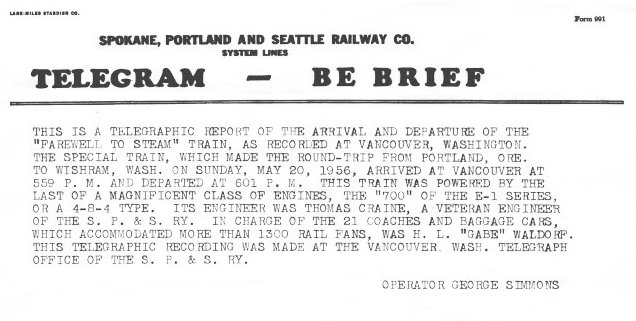
- 1958 - The SP&S 700 is donated to the City of Portland on January 14 following Union Pacific's donation of the OR&N 197 (then UP 3203). Southern Pacific later adds #4449 to the city's impressive collection. The three steam locomotives sit together in Oaks Park for nearly two decades until, in 1975, the SP 4449 is restored for operation on the American Freedom Train.
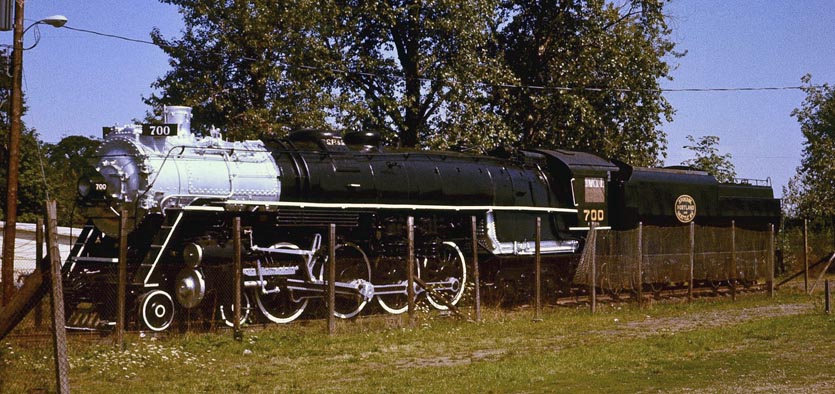
SP&S 700 on display in Portland's Oaks Park in 1978
Photo by Steve Morgan, © 1978.
Bibliography:
- Gaertner, John T., North Bank Road: The Spokane, Portland & Seattle Railway, Pullman, WA, 1992.
- Grande, Walter R., The Northwest's Own Railway, Vol. 1, Grande Press, 1992.
PRPA Work History
Through the efforts of the PRPA, the SP&S 700 is today very much as it was when it was first manufactured and accepted by the SP&S in 1938. Years of exposure to the elements in Oaks Park meant that significant restoration efforts were needed to return the 700 to high-speed service as a passenger train engine. Most of the work on the 700 after the initial restoration addressed damage that had accrued through years of the normal wear and tear of operations and deferred maintenance while still in service (there are indications that normal maintenance routines were deferred during the 700's last years of service as the railroad anticipated replacing the locomotive with a diesel-electric).
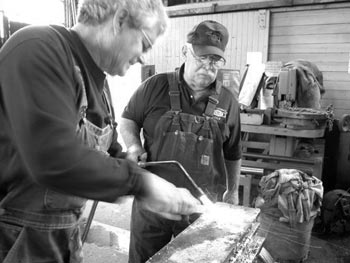
John and Roy clean the crosshead in
preparation for re-Babbitting
Brooklyn roundhouse, Fall 2008
Photo by Terry Thompson
The PRPA has made every attempt to repair and maintain the locomotive as it would have been while still in service 70 years ago. Whenever possible, we use repair and replacement parts like those removed (unless higher quality is specified in blueprints) and when feasible we employ the repair technologies in use in the 1930s and 1940s. In some cases, new and better materials have been used, but they are indiscernible to the untrained eye. All mechanical repairs conform to the builder's drawings. None of the work has been an improvement or modification to the locomotive's initial design and construction except for the installation of the MU controls to let the 700's engineer operate a trailing helper diesel, a required capability when operating out on a modern mainline. The following list captures the milestones, repairs, major maintenance, and restoration work performed by the PRPA on the 700 over the last 20+ years:
- 1977: Chris McLarney founded the PRPA to help restore the SP&S 700. McLarney had been one of the volunteers in the SP 4449's restoration, but at only 15 years of age, he was considered too young to go out on the road with the locomotive when it left town to lead the American Freedom Train. McLarney turned his attention to the 700, cleaning and oiling various parts and dreaming big dreams.
- 1985-1987 (at Oaks Park): Removed asbestos and replaced it with mineral wool and other safer materials; repaired exterior of the boiler; boiler frame and jacketing replaced; wood deck on tender replaced; repaired sheet metal and painted tender; and repaired electrical lines and switches for lights.
- 1987: Removed from Oaks Park Nov 9 (see KPTV news coverage on YouTube), deadheaded to Union Station for display, and then taken to Brooklyn Roundhouse.
- 1988-1994 (at Brooklyn Roundhouse, as all work since): firebox side sheet and boiler repaired; sheet metal repaired and locomotive painted; drawbars inspected; cab windows, seats, and woodwork replaced; feedwater pump replaced with same model as original; cylinder valves and main pin bored and milled; brass bushings on driving rods inspected and repaired; mineral wool insulation installed on boiler; superheaters tested and repaired; boiler washed out (5 times); and four Federal Railway Administration (FRA) inspections.
- 1990: First steam-up after restoration occurred on May 15, followed by test runs to Longview, WA and Wishram, WA on June 13 and 23, respectively.
- 1995-1999: Radius rod replaced (engineer's side); valve cage re-bored; driver equalizer pins and bushings inspected, some replaced; all driver main springs replaced; tender water tank repaired and cleaned; electrical system repaired; and four FRA inspections.
- 2000: Boiler completely rebuilt to comply with the new FRA Form 4 requirements including the following: removing the superheater units, removal of tubes, assessment of boiler condition, sandblasting, pressure testing the superheater units, ultrasonic testing, swaging the flues, re-stuffing the flues, boiler coating, and a good deal of other miscellaneous boiler and firebox work, including removal and replacement of insulation and jacketing.
- 2001-2002: Rebuilt the power reverser; align-bored the valve cylinders; installed new valve cages, rings and bull rings in valve cylinders; assembled and inserted valves into valve cylinders; removed, inspected, and repaired drive pistons and cylinder heads; rebuilt the feedwater pump; all superheater tubes removed, tested, repaired and reinstalled; removed and rebuilt the cylinder cocks and mechanical lubricators; replaced all of the firebrick in the firebox and performed inspections and minor repair to the firebox floor; replaced all wheels and roller bearings on the tender; inspected and machined driving rod connectors; measured and analyzed driving wheels and main suspension; added Multiple-Unit (MU) controls; repaired one of two air pumps; painted locomotive; boiler maintained and washed; various steam valves machined and repacked; draw bars inspected; and inspection by the FRA.
- 2002-2003: Replaced cold water line to feedwater pump; rebuilt injector; replaced the tender's wheels and bearings; repainted tender and logo; rebuilt and replaced both air pumps; replaced all lubrication lines.
- 2004-2005: Machined (in place) to resurface all eight driver wheel tires to original profile; replaced broken suspension spring; replaced stolen main boiler steam gauge with one from the collection of Bill Shannon donated by the Shannon Family; cleaned and inspected main suspension, equalizers, and brake rigging; removed number boards (which were not original) from the top of smokebox.
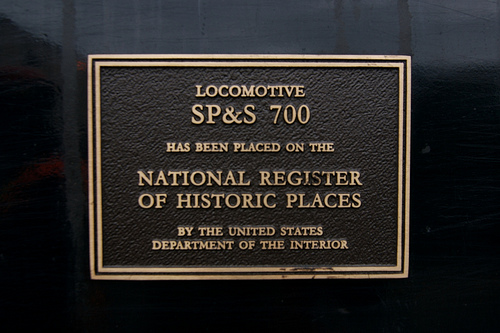
- 2006: Certified metallurgical analysis of possible damage from December 2005 derailment (clean bill); replaced all wheels on pilot truck; inspected and repaired pilot truck suspension, attachment, and brake rigging; inspected and repaired airbrake control stand; replaced broken springs on trailing truck; and renewed pivots and pins on equalizers.
- 2006: United States Department of The Interior added the SP&S 700 to the National Register of Historic Places on January 25, after a PRPA effort lead by Arnie Holden.
- 2007-2008: Fabricated new flange for boiler check valve; re-babbitted fireman's side crosshead.
- 2009: Re-bricked firebox.
- 2010: Repaired bottom rack in front truck.
- 2011: Rebuilt lateral motion device on driver #2.
- 2012: Replaced tire on fireman's side wheel of driver #3.
- 2016-2023: FRA 1472-day boiler inspection begins along with several other jobs. Removed all jacketing, lagging, tubes and superheaters; cleaned boiler interior and completed form 4 ultrasonic testing of boiler wall thickness; repaired firebox sheet and replaced fire pan; manufactured and installed new stay bolts, new piping on the boiler exterior, and new superheaters; replaced tubes, installed firebox brick, rebuilt air pump and check valve, repaired sand dome and steam dome; applied protective paint to boiler exterior; completed hydrostatic test.
In addition to the work of PRPA volunteers, excellent initial design and manufacturing have certainly played a role in the locomotive's preservation in its as-received state. All of the features that exemplify the 700's character as "state of the art" were incorporated when it was built, and the SP&S found no reason to add to or improve upon those features during the 700's eighteen years of service.
On the other hand, detailing has varied over the years. In the 1940s, lighted number boards were added atop the smokebox. For the 1956 "Farewell to Steam" excursion, the engine was cleaned, and the smokebox was painted silver. In 1990, the smokebox was again painted silver, the valve and drive cylinder covers were chromed, and new logos were put on the tender. Subsequent work by the PRPA has restored the SP&S's original logos to the tender, returned the cylinder covers to their original black, removed the number boards, and returned the smokebox to its as-delivered graphite grey. Thus, the 700 today is virtually identical in function, appearance, and capability to the locomotive that was built in 1938.
Specifications

Builder: Baldwin Locomotive Works
Delivered: June 20, 1938
Wheel Arrangement: 4-8-4, "Northern"
Driver Diameter: 77"
Boiler Pressure: 260 psi
Piston Bore x Stroke: 28" x 31"
Length: 110' 6 3/4" with tender
Weight: 485,820 lbs. engine only when operating (with water in boiler), 296,000 on the drivers
Fuel: Bunker C fuel oil
Tender Capacity: 20000gal water, 6000gal oil
Not sure how to interpret these figures? See our brief tutorial.
Comparisons with Other Steam Locomotives
Of the thousands of large steam passenger engines that ran in the 1940s, few still exist, and even fewer can be operated to pull passenger trains on main-line railroads. To illustrate, the website www.steamlocomotive.com reports that of the over 1,100 4-8-4 "Northern" locomotives built for North American railroads, fewer than 50 still exist and only six of those are identified as "operational." When her 1472-day inspection is complete, the 700 will rejoin this small cohort of large steam locomotives that are complete, in good repair, and capable of the kind of work for which they were designed. All that said, there is no disputing that the United States entered a new golden age of big steam with the return to service of UP 4014 and several other large steamers. Before the SP&S 700 was shut down for her second FRA 1472-day rebuild and inspection at the end of 2015, she was the largest, the second heaviest (engine only, behind N&W 611), and the second strongest (behind N&W 611) of the then operating steam locomotives in North America. When she returns to service, the 700 will be fifth on all three measures:
| Locomotive (Road, #) |
Wheel Config. (Whyte) |
Weight (lbs) | Length | Driver Diam. (in.) |
Tractive Effort* (lbf.) |
Boiler Press. (psi) |
Piston Bore×Stroke (in.) |
Builder | Year Built | Disposition | ||
|---|---|---|---|---|---|---|---|---|---|---|---|---|
| Total | Engine Only | On Drivers | ||||||||||
| UP 4014 | 4-8-8-4 | 1189500 | 762000 | 540000 | 132' 9-1/4" | 68 | 135375 | 300 | 23.75×32 | ALCO | 1941 | Operating |
| UP 3985 | 4-6-6-4 | 1073900 | 627000 | 404000 | 121' 10-7/8" | 69 | 97350 | 280 | 21×32 | ALCO | 1943 | Stored |
| N&W 1218 | 2-6-6-4 | 951600 | 573000 | 433350 | 121' 9-1/4" | 70 | 114000 | 300 | 24×31 | N&W | 1943 | Stored |
| WM 1309 | 2-6-6-2 | 643100 | 434900 | 366700 | 99' 6" | 56 | 98300 | 210 | 22x32 35x32 |
Baldwin | 1949 | Operating |
| AT&SF 2926 | 4-8-4 | 961000 | 510700 | 294000 | 120' 10" | 80 | 79968 | 300 | 28×32 | Baldwin | 1944 | Operating |
| N&W 611 | 4-8-4 | 872600 | 494000 | 288000 | 109' 1-3/4" | 70 | 77899 | 300 | 27×32 | N&W | 1950 | Operating |
| UP 844 | 4-8-4 | 907890 | 486340 | 266490 | 113' 9-3/4" | 80 | 63750 | 300 | 25×32 | ALCO | 1944 | Operating |
| SP&S 700 | 4-8-4 | 879700 | 485820 | 296500 | 110' 6-3/4" | 77 | 69800 | 260 | 28×31 | Baldwin | 1938 | Rebuilding |
| C&O 614 | 4-8-4 | 865530 | 479400 | 282400 | 112' 8-1/2" | 72 | 68300 | 255 | 27.5×30 | Lima | 1948 | Stored |
| AT&SF 3751 | 4-8-4 | 874346 | 478100 | 278000 | 108' 7" | 80 | 65981 | 230 | 30×30 | Baldwin | 1927/1941 | Operating |
| SP 4449 | 4-8-4 | 869800 | 475000 | 275700 | 110' 2-1/4" | 80 | 64760 | 300 | 25.5×32 | Lima | 1941 | Operating |
| MILW 261 | 4-8-4 | 824100 | >460000 | 259300 | 109' 7-7/8" | 74 | 62119 | 250 | 26×32 | ALCO | 1944 | Operating |
| RDG 2102 | 4-8-4 | 809000 | 441300 | 278200 | 110' 6" | 70 | 68000 | 240 | 27x32 | Baldwin | 1925/1945 | Operating |
| PM 1225 | 4-8-4 | 727300 | 442500 | 277600 | 101' 8" | 69 | 69350 | 245 | 26×34 | Lima | 1941 | Rebuilding |
| NKP 765 | 2-8-4 | 802500 | 440800 | 264300 | 100' 8-3/4" | 69 | 64135 | 245 | 25×34 | Lima | 1944 | Operating |
| UP 5511 | 2-10-2 | 539200 | 362200 | 288700 | 63 | 70449 | 200 | 29.5×30 | Baldwin | 1923 | Stored | |
*Not including boosters